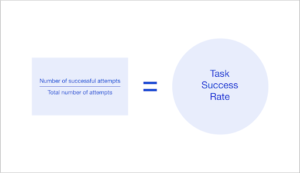So you’ve researched the best UI/UX strategy to incorporate into your site. You may have even then gone ahead to integrate it?
What’s next, how do you measure if your strategy has been a success? How do you know if your audience is actually having a good UX experience while browsing your site?
Measuring the effectiveness of your UX strategy is a vital part of the UX component.

Image credit: Adobe XD
By comparing the UX experience with specific qualitative and quantitative methods, you can glean the effectiveness of your UX approach. The key parameters that influence the metrics you should keep an eye on are:
Your users: These are the people you had in mind when planning and building the product. Their needs and psychographics have influenced much of the choices made in the UI and UX features.
Your objectives: The intended objective that should be carried out by the users when building the product. It could be something as basic as filling a form or something more elaborate like customer conversion and retention.
Here is a simple guide that takes into account proven methods to measure the impact of your UX strategy:
Task Success Rate

Image Credit: Toptotal
This is a vital means to measure the success of your UX approach. Essentially, it refers to the number of users that successfully complete a task on your site. This is also known as the Task Completion Rate. Ahead of measuring the task success rate, you should set clearly defined goals, such as the amount of time it would take to complete a signup page or to fill a form.
Comparing the eventual result to the KPIs you set will help you how quickly and smoothly it is to perform a task on your site. This contributes to the overall performance of your site.
Mobile-Friendly Optimization
The bulk of internet users now accesses websites through their mobile phones. The average netizen has come to expect websites to immediately adapt to mobile viewing, nobody wants to go and start tweaking their settings to adjust for mobile. Not many people even know how to do that, so having a non-mobile-friendly product can be off-putting for users.
Ensure you test your website on various mobile devices from several manufacturers to measure how it responds to all.
Conversion And Retention Rate

Image credit: Main WP
The conversion rate on your site refers to the number of users who perform a specific action, such as a signup or a purchase. The retention rate refers to the number of users that continuously visit the site over a defined period of time.
Conversion rate gives you an idea of how many people the layout of your site was able to drive to carry out a defined action while the retention rate helps you measure the number of long term users.
Customer Satisfaction Measurement
At every stage of using the product, it is important to gauge how happy or satisfied your clients are by measuring their customer satisfaction level.
One of the easiest ways to know if your customers are happy with your UX is to simply ask them. By scheduling pop-ups asking users to rate specific actions on your website, you can determine a percentage showing how users feel about various aspects of your product.
Error Rate
The error rate refers to how often users try and fail to carry out a specific action or task. This gives you a sense of what areas your users are struggling with.
You can track how common mistakes are at a specific area of the site. This will help you determine if you need to simplify some processes, provide additional user guides or tweak your existing guides.
Benefits Of Measuring Your UX Strategy

Image credit: MJV Technology & Innovation
Measuring your UX strategy helps you learn what is working and what you should ditch. It enables you to know how your actual customers are interacting with your website or app and if it contributes positively to your campaign goals. Core benefits of measuring your UI/UX performance include:
Adjust Your Design Approach
By learning what your clients actually respond positively to, you will not just be throwing ideas blindly into the mix but actually creating what users need. You will be able to respond swiftly to constant changes and new trends that prove valuable.
Strategise New Methods
Learning how your customers’ needs evolve will aid you in brainstorming innovative ideas that will boost acquisition and retention. This can come in beyond product design and can go as far as influencing your marketing and customer relationship management.
Understand Your Customers Better
Measuring your UX strategy means you better understand the profile of people that find your products useful. If your product solves the problem of certain demography you hadn’t considered earlier, you could have an increased customer base.
If you would like to measure the state of the UI and UX of your products or discover highly effective upgrades you can make, book a free consultation with us here.
We are Charisol, a software development agency with a community of talented software developers that leverage the “work without walls” culture to provide solutions for clients around the world. Our services span Software designing, App development, Digital Marketing, Social Media Marketing, Content Writing & Marketing, and Search Engine Optimisation. Follow us on Medium or on social media (Facebook, Instagram, Twitter, LinkedIn).

